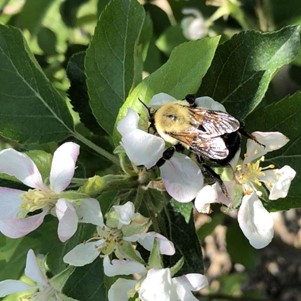 Old Guys. Honey Report. Invasives.
Old Guys. Honey Report. Invasives.
By: Kim Flottum
There are few things I enjoy more than attending a beekeeper’s meeting. It’s a place where everybody thinks like I do, likes mostly the things I do, gets the same jokes, has the same problems, and has mostly the same aches and pains I do for the same reasons. I’m pretty much at home when I’m sitting with a bunch of folks who deal with live, venomous, stinging insects on a routine basis, and enjoy the job as much as I do.
You know the conversations that go on, some in the halls, some at the bar, some with the guy sitting next to you that you didn’t know until a few minutes ago…how many, how much, lost any, did’ja read, what’r the latest prices and costs, heard about that new supplier and more new rules and it’s all about next season. They’re all different, but they are all so much the same.
Some, those newest to the mix tend to stay on the edge, just listening, thinking what could I add to the noise that anybody’d be interested in. You can see them over there, maybe two or three or five or six all thinking the same thing, feeling a bit left out but soakin’ it all in, just soakin’ it all in. But the urge to ask just one of the million questions they have shows in every move they make…where they are, how they stand, how long to get back in the room, how many vendors they visit and twist arms with about which is best and how to do it right this time. And lookin’ and touchin’. One of them points to the old guy in the middle of a bunch of other old guys…all graying, dressed kind of nice for a beekeeper’s meeting, maybe cowboy boots and a sport coat, kind of a weathered face from decades outside and gnarled hands from a million stings and long hours workin’ bees, ridin’ the truck and the ‘cat, and sortin’ and stackin’ and kickin’ and swearin’.
At the higher-up meetings there’s usually several of those old guys. All told they’ve got centuries of experience, thousands of miles, most with more good years than bad, tons and tons and tons of honey, years away from homes far away…and one good man back at the warehouse who keeps everything in shape…in the shadows. He may be a veteran, a long-timer with bees of his own, almost as much experience as the boss but not quite the risk or responsibility. Still, he suffers as much when things go bad even when he’s not the reason, and doesn’t quite get the same rewards when things go right. Maybe he’s family – a son, brother or nephew who grew up in the business with a knack for the bees or trucks or people and likes those more than the meetings and socializing. But even a family guy gets similar rewards…good, but not the best.
A good friend, one of those old guys, once said that it’s always good to see the top bees at a meeting, but too seldom do you see the guy who’s mostly always back home keepin’ it all together, most all of the time. And who needs to know what’s going on at the meetings? The old guy? Or the guy makin’ it work…
*
I don’t know how much you use the Monthly Honey Report we put out each month. If you’re a regular reader you noticed that it changed this month. Change comes slow to our honey report. In over 40 years we’ve only changed the map twice from the original.
Back in March of ’86, when I started, we had nine regions (and had had that many for decades) but when I got here there were not enough reporters to fill all the prices in every region every month, so sometimes there were gaps. We fixed that in a hurry by enlisting many more reporters in every region so that now there is always data for every product in every region. You should be impressed that there are several reporters in every region that produce Ross Rounds or sell pints of honey. You should be more impressed that these good folks do all this work every month for only a free subscription. Thank you again good people.
In May that same year we started doing a bit of analysis for each product by offering the range – from lowest to highest across all regions – of prices for every product plus the average price of each product across all prices for all regions. You may think that’s not especially useful, but that ‘average’ price is the single best predictor of how that particular commodity is doing over time. The biggest value of our report is the ‘trends’ you see over time as opposed to the exact price each month in any one region. Is the price going up, down or remaining about the same? Watching that will tell you much about the honey market in general. And, watching those trends in your particular region will tell you the same, but a bit closer to home.
Another way we make it easy to watch those trends is to provide historical data each month for every product, which began in February of 1990. We were already providing the ‘average’ price of that product for the current month, but then we added the ‘average’ price of the product from the previous month, and from the same month from the previous year. So for the past 23 years you have been able to get an ongoing picture of what that product is doing in the market place now, last month and last year in one place at the same time. As automated as spreadsheets are and databases have become, it still takes about a half day to gather, sort, figure and analyze all that data every month.
In January 1991 we redrew the map after analyzing the prices in every state and finding that the markets were consolidating as fewer suppliers were making contributions to the market, mostly in the Northeast and Southwest. We went from our original nine regions to eight, kept the range and average price analyses columns and settled in. Over the next several years the products we measured changed with the market. We removed the 2.5 pound jar and added quarts and pints at both wholesale and retail prices. For a time we offered a price index by analyzing the prices for every product in a region and developed a weighted average and assigned the region with the highest average a value of 1.0. We then compared every other region to the highest and came up with a percentage figure for each region compared to the highest. We kept that for a bit, but found it to be of little value in the long run so discontinued using it. And there it stayed for quite some time. We added and replaced reporters on a consistent basis making our pricing data more robust and fine tuned. Plus, we do a year end to end comparison so you can see how much things have changed in a 12 month period for every product in every region.
What did change was the survey we sent our reporters each month. Because our reporters, by design, represent a very good cross section of the beekeeper population as a whole – hobby, sideline and commercial, and packers, plus a large enough sample size of each in every region – we feel fairly confident not only about the pricing data we have, but about our survey results when we ask about beekeeping practices, marketing ideas, pest and disease controls, and all the other topics we cover.
Our survey results offer a good overview of what’s going on across the nation relative to management and marketing and pricing. So good, in fact, that the National Honey Board uses our data on their web page for prices. And now that the BIP folks have some depth in their data, we are beginning to look at how our reporters, though a much smaller sample size compared to BIPs sample are able to predict certain issues in US beekeeping and honey bee management. Time will tell, but early on we are encouraged by the results.
The next addition to our data was to offer the price per pound column to our chart. Begun just 12 months ago, each commodity has a price per pound value shown that enables you to make a wiser decision on which product to sell. Obviously honey in the barrel offers the least price per pound, while the retail price of half pound and comb honey products offer the most. They both have their respective costs so you can figure out which is the best, easiest and most profitable for your operation. But we give you the numbers you need to do the math. You won’t find these figures anywhere else by the way. Just so you know.
And now, another change. Looking at the map this month you’ll note there are only seven regions. From nine to eight to seven. This represents again a redesign configured by looking at pricing for every state compared to every adjacent state, using that weighted index we used some time ago. And again, consolidation has resulted in some predictable changes. Even though the geography may seem a bit odd, the honey selling practices and prices are more similar in each region than in other regions, hence the groupings the way they are. It’s not perfect, but we are comfortable with the new design.
Even if you don’t sell honey we encourage you to review that page every month. There’s good beekeeping information offered there by experienced beekeepers from every region, and even more importantly there are good marketing tips and tricks offered there too. Plus, the monthly historical data is valuable so you can see how much things have or haven’t changed in your region, and across the country every month.
•
So, about the hats. This month we give a ‘Tip of the hat’ to TSC, the Tractor Supply Company, that sells a lot of our magazines from their magazine racks across the country. We have a TSC store here in Medina and they sell out every month. Go figure. But in recent issues you’ve seen hats from Boise (ID) State, Maxant, (with a particularly attractive design on the side), Blue Sky Bee Supply with a catchy new logo on the front, and Mann Lake Bee Supply, with a good looking design. But, here’s where this is going. There’s all manner of attention-getting bee-themed hats out there. From beekeeper associations, businesses, wherever and whatever. We’d like to share your design with the rest of the thousands of Bee Culture readers. So here’s what we’ll do. Send us a photo of your hat, and we’ll take a look. We’ll pick some and let you know, and then you can send us a (new, please) hat and we’ll show it off here. Send the photo to me via email, at Kim@BeeCulture.com, and we’ll see what we’ll see. I already have a collection of nearly 100 hats so we’ll be using some of those on occasion too, but for now send us your best work, and Good Luck.
•
I’ve been to California enough to see clearly some of the things that California agriculture must deal with. Specifically, I’ve been looking at the plant and animal pests and diseases they want to keep out of the state. Greening in the citrus growing area is a good example. That disease has pretty much destroyed the honey/beekeeping marriage of the Florida citrus industry. Finding orange blossom honey is a lot harder today than five years ago and it’s added greatly to the cost of growing those crops. And that’s just one.
Think fire ants. California has them in some places…from nursery crops mostly I’m told, but they don’t want more, that’s for sure. And what about yellow starthistle…a wonderful honey crop, but a bane to pastures grazed by cattle. And they don’t want small hive beetles, either.
In fact, California so doesn’t want so many things they have set up inspection stations at the main border crossing highways to check and make sure nobody brings in anything they don’t want. This has proved difficult for trucks carrying beehives on pallets because all manner of creatures can hide between pallets, under pallets, and in, on and around the hives. After all, they’ve been sitting outside for months and plants and animals and seeds and fungi and what all can and will hitch a ride.
Nobody compares to California’s level of enthusiasm for this. They cooperate with several states in an “ant free” certification program where the colonies are inspected and guaranteed to be ant free by the sending state. To qualify, hives and pallets must be high-pressure washed so all equipment is clean of dirt, plant material or other debris. Ant infested hives and rotten or broken equipment must be removed. At the same time they are also looking to see if invasive weeds are growing on the bottoms of those pallets. If they find something, there’s a delay until they ID it…and that may mean taking a photo and sending to an ID expert…during regular business hours, by the way. And they are zealots about this. They don’t want strangers from a strange land calling California home.
So, what about your state? How much enthusiasm does your Agriculture department show when a truck full of colonies on pallets crosses your state border? Do they do anything at all to keep out those out-of-state beasties that ride along on pallets and beehives out-of-state? Or do they assume the sending state already checked and things are fine? But what if the sending state either doesn’t care, doesn’t check, or doesn’t even know the truck left in the first place? Or has your state simply thrown up its hands and said we can’t afford to look?
So who knows if Asian Longhorn Beetles are living in the pallet? Or if Brown Marmorated Stinkbugs or Emerald Ash Borers are hitching a ride? Who checks the truck bed for bunches of fire ants riding along? And is anybody at all checking the trunks of the family car to make sure there’s no plant or animal contraband lurking under that suitcase? All in all, the official list of invasives that could be riding on that truck…including amphibians, arachnids, plants, insects, pathogens, reptiles and mollusks, not to mention nemotodes, birds, crustaceans, mollusks, and fish, is 2,826 species long. And counting.
We all know most states have mostly given up on these types of inspections. The Ag community isn’t strong enough to push it, and the urban community doesn’t care and doesn’t want to pay for it. Another bug, so what? Isn’t that flowering weed in the river pretty? When the pet snake gets too big, just let it go in the swamp. But by then it’s too late and the bugs have killed all the trees on a hundred city blocks and those pretty flowers have clogged the river and caused a stink and the snakes are eating family pets. Then it’s spend a bunch to clean it up. Plant new trees. Dredge the river. Spray the weeds. Hunt the snakes.
What about those things that come along and find your hives? Varroa didn’t walk here from Asia. African bees didn’t fly here from Africa. Is anybody protecting your bees from the nasties of the world? Yes, it seems they are, but only if you live in California. For the rest of us, it’s keep your eyes open, your ear to the ground, and go look over the hill to see who’s moved in and brought who knows what with them and couldn’t care less about sharing. It’s every bee for herself out there.
•
It’s January. It’s already started out there. Be ready. Be careful.






